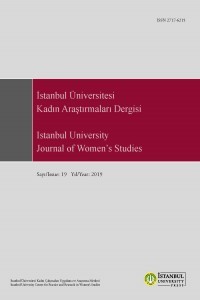AB ÜLKELERİNDE YÜKSEKÖĞRETİMDE CİNSİYETE GÖRE KAYIT ORANI FARKI İÇİN İSTATİSTİKSEL BİR ANALİZ
Yükseköğretimde cinsiyete göre devam oranı farkı dünya genelinde yaygın bir sorun olarak karşımıza çıkmaktadır. Bu fark zamana ve ülkelerin gelişmişlik düzeyine göre azalmasına karşın hala önemini korumaktadır.
Çalışmada, AB ülkelerinde yükseköğretimde cinsiyete göre kayıt oranı farkının anlamlılığı, 2014 yılı Dünya Bankası Veri tabanı verileri kullanılarak istatistiksel olarak incelenmiştir.
Çalışmada elde edilen temel sonuç, AB ülkelerinde yükseköğretimde cinsiyete göre kayıt oranı farkı kızların lehine olarak istatistiksel olarak anlamlı bulunmuştur.
Sonuç olarak, sürdürülebilir sosyal, ekonomik ve politik gelişme ve toplusal refah için yükseköğrenimde cinsiyete göre okul kayıt oranı farkının en aza indirilmesi için stratejiler ve politikalar geliştirilmesi hayati olduğu açık bir durumdur.
Yükseköğretimde cinsiyete göre devam oranı farkı dünya genelinde yaygın bir
sorun olarak karşımıza çıkmaktadır. Bu fark zamana ve ülkelerin gelişmişlik
düzeyine göre azalmasına karşın hala önemini korumaktadır.
Çalışmada, AB ülkelerinde yükseköğretimde cinsiyete göre kayıt oranı
farkının anlamlılığı, 2014 yılı Dünya Bankası Veri tabanı verileri kullanılarak
istatistiksel olarak incelenmiştir.
Çalışmada elde edilen temel sonuç, AB ülkelerinde yükseköğretimde cinsiyete
göre kayıt oranı farkı kızların lehine olarak istatistiksel olarak anlamlı
bulunmuştur.
Sonuç olarak, sürdürülebilir sosyal, ekonomik ve politik gelişme ve
toplusal refah için yükseköğrenimde cinsiyete göre okul kayıt oranı farkının en
aza indirilmesi için stratejiler ve politikalar geliştirilmesi hayati olduğu
açık bir durumdur.
Anahtar Kelimeler:
Yüksek Öğrenim, Cinsiyete Göre Kayıt Oranı Farkı, AB Ülkeleri
A STATISTICAL ANALYSIS FOR THE GENDER GAP IN COLLEGE ENROLLMENT IN EU COUNTRIES
The gender gap in college enrollment in the mean is historically observed widespread throughout the world. This gap remains as a serious problem despite the decrease from the past to the present day.
In this study, it is statistically tested according to the World Bank database whether for the gender gap in college enrollment in EU countries is valid.
As a result of the statistical analyzes and tests in the study, it was determined that the gender gap in college enrollment in EU countries in favor of the girls is valid.
As result, it is clear that it is vital to develop strategies and policies in order to minimize the gender gap in college enrollment for achieving sustainable social, economic and political development and social welfare.
The
gender gap in college enrollment in the mean is
historically observed widespread throughout the world. This gap remains as a
serious problem despite the decrease from the past to the present day.
In this study, it is statistically tested according to the
World Bank database whether for the gender gap in college enrollment in EU countries
is valid.
As a result of the statistical analyzes and tests in the
study, it was determined that the gender gap in college enrollment in EU countries
in favor of the girls is valid.
As result, it is clear that it is vital to develop strategies
and policies in order to minimize the gender gap in college enrollment for
achieving sustainable social, economic and political development and social
welfare.
___
- • World Bank, World Development Indicators, 2017
- • Sulayman S AL-Qudsi, Family background, school enrollments and wastage: evidence from Arab countries, In Economics of Education Review, Volume 22, Issue 6, 2003, Pages 567-580,
- • Lina Song, Simon Appleton, John Knight, Why Do Girls in Rural China Have Lower School Enrollment?, In World Development, Volume 34, Issue 9, 2006, Pages 1639-1653,
- • Donghun Cho, The role of high school performance in explaining women's rising college enrollment, In Economics of Education Review, Volume 26, Issue 4, 2007, Pages 450-462,
- • Janine Huisman, Jeroen Smits, Effects of Household- and District-Level Factors on Primary School Enrollment in 30 Developing Countries, In World Development, Volume 37, Issue 1, 2009, Pages 179-193,
- • Ryan Wells, Gender and age-appropriate enrolment in Uganda, In International Journal of Educational Research, Volume 48, Issue 1, 2009, Pages 40-50
- • Miet Maertens, Ellen Verhofstadt, Horticultural exports, female wage employment and primary school enrolment: Theory and evidence from Senegal, In Food Policy, Volume 43, 2013, Pages 118-131,
- • Matthew T. Johnson, The impact of business cycle fluctuations on graduate school enrollment, In Economics of Education Review, Volume 34, 2013, Pages 122-134
- • April Bleske-Rechek, Kingsley Browne, Trends in GRE scores and graduate enrollments by gender and ethnicity, In Intelligence, Volume 46, 2014, Pages 25-34,
- • Dylan Conger, High school grades, admissions policies, and the gender gap in college enrollment, In Economics of Education Review, Volume 46, 2015, Pages 144-147,
- • Pushkar Maitra, Sarmistha Pal, Anurag Sharma, Absence of Altruism? Female Disadvantage in Private School Enrollment in India, In World Development, Volume 85, 2016, Pages 105-125,
- • Rita Ray, Rajlakshmi Datta, Do separate female toilets in primary and upper primary schools improve female enrollment? A case study from India, In Children and Youth Services Review, Volume 79, 2017, Pages 263-273,
- Yayın Aralığı: Yılda 2 Sayı
- Başlangıç: 2019
- Yayıncı: İstanbul Üniversitesi
Sayıdaki Diğer Makaleler
ANTİK YAZARLARDA SAVAŞÇI BİR PERS KADINI: RHODOGUNE
İNGİLTERE’DE YÜKSEK ÖĞRENİMDE CİNSİYETE GÖRE ÜCRET FARKLILIĞI İÇİN İSTATİSTİKSEL BİR ANALİZ
AB ÜLKELERİNDE YÜKSEKÖĞRETİMDE CİNSİYETE GÖRE KAYIT ORANI FARKI İÇİN İSTATİSTİKSEL BİR ANALİZ
